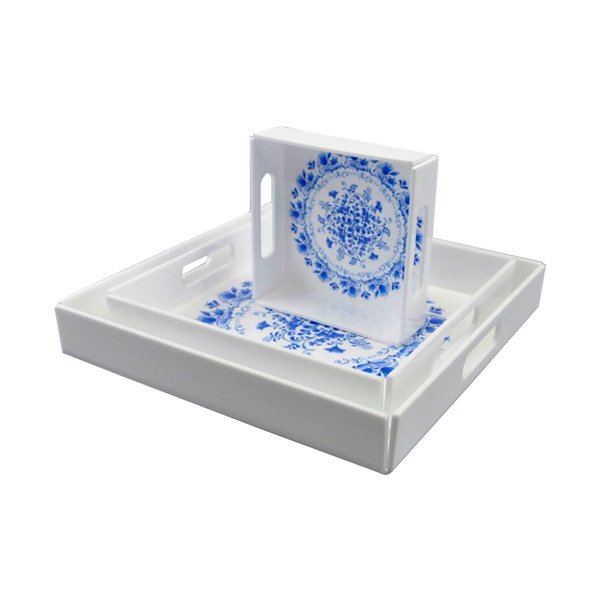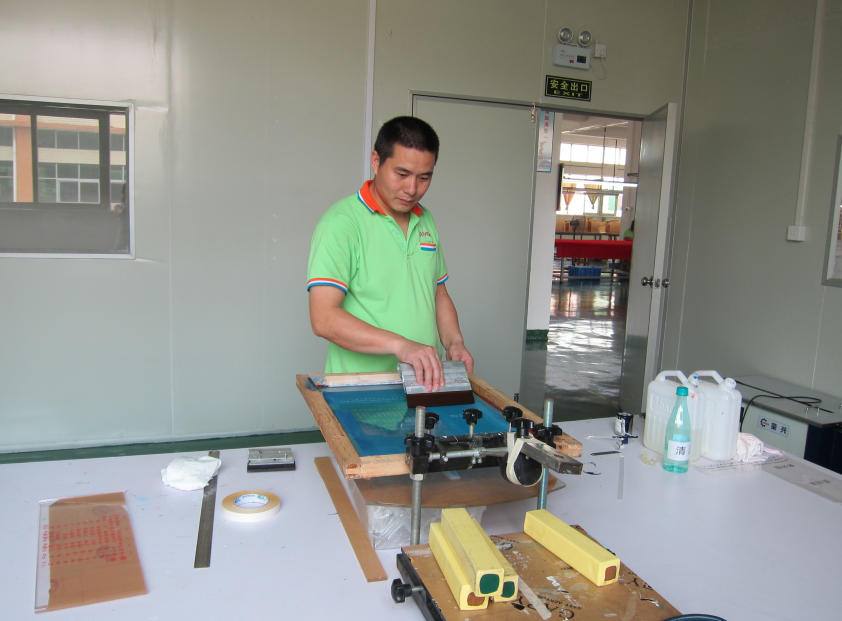As a new star in the printing market, UV printing is increasingly outstanding. On the other side, traditional printing methods, for example, screen printing is always an important part of the printing industry. At least for now,it’s still necessary. So, what’s the difference between UV printing and screen printing.
The excessive drying time and limitation of printing only on acrylic led to the evolution of the new rage-UV printing. With built-in UV light, the ink dries up instantly and does not lead to smearing or blotching. UV printing enables the printing of dark and white images together on the same surface. With photo-quality results the efficiency and the quantum of printing have gone up tremendously, lowering the overall costs. Let’s see these two printing methods and how it applies to acrylic products.
Silk Screen Printing for Acrylic Products
Silkscreen printing commonly known as screen printing is the process of transferring ink onto the acrylic substrate through a mesh, using a squeegee/roller to fill the open apertures. It is a traditional print technique that’s been used for many years. In the screen printing process, a type of stencil design is created on fine mesh or polyester fabric, with several layers of ink pushed through this stencil layout onto the surface of the print material. Different screen stencil is applied in all the different ink colors to create the final printed effect. An impermeable substance is used to cover areas of the print material which need to be left clear to prevent ink contamination.

Why Silkscreen printing for acrylic products?
One of the major benefits when it comes to screen printing is that it is an effective solution for bulk printing as it is also extremely cost-efficient. Other benefits include:
- The acrylic itself is also affordable, this makes it to be cost-effective since you don’t need any equipment to start your work.
- Acrylic does not fade, tear, stain, wrinkle or peel off. Also, it can last long for close to 10 years without yellowing.
- It protects against moisture if printing is done directly on acrylic.
- Acrylic is resistant to shattering, light in weight, and has glass-like qualities like clarity, brightness, transparency, and translucence. (no any relation with silk-screen,should clarify the influence with silk screen if you write this point here )
- Screen printing on acrylic is unique, especially when compared with other printouts from other substrates. This is because it provides sleek, modern, and vibrant looks which are terrific in contemporary decors.
- Gives a refractive light that is almost 3-D like and gives greater color vibrancy.
- It is open to creativity as it can be tinted or colored, mirrored, or made opaque depending on how you want it.
- Many coatings can be applied to a sheet for performance to enhance resistance, anti-fogging, glare reduction, and solar reflexivity.
Common Problems in Acrylic Screen Printing
Below are some of the identified challenges that you are likely to face when printing on acrylic.
Bleeding of colors
This happens when the pigment is loose. During printing, at every registration, the printing paste will bleed to the surrounding areas of the image on acrylic. This spoils the printed image. The solution here is that you should ensure that the paint is thick to the extent that it will stick to the acrylic. Also, at every registration, make sure you clean the under part of the screen.
Unequal gaps left between repeats
Sometimes, repeats of the design do not join. Therefore, you have to make sure you calculate the registration of the screen. You also have to check the repeats just before printing begins.
Irregular screen placement
This happens when you don’t check the repeats. Therefore, you have to check the repeats before you place the screen to register the print.
Formation of color patches
Ensure the use enough ink and to pull the squeegee properly over the image, as the formation of color patches occurs when the color is not evenly distributed on acrylic
UV Printing for Acrylic Products
UV printing is a unique method of digital printing utilizing ultraviolet (UV) light to dry or cure ink, adhesives, or coatings almost as soon as it’s hit the acrylic products

Why UV printing for acrylic products?
UV printing is often recommended for customers looking for one-off prints and small quantity print runs.
UV Printing is no relation with quantity, actually the more quantity, the unit price will be better
Advantages include:
- It has a low set up cost and speed of turn around
- It is easy to print in a range of different colors
- It transfers photographic images accurately
- It is best for one-off or short print runs
- Prints can be customized in a variety of ways
- Designs sit flat on the print material and do not bulge out from the surface
Common Problems in Acrylic Screen Printing
Two main factors of the UV print system that might affect the clean and clear acrylic product:
The flying inks will stain the materials with some small ink droplets.
All of the UV printers are delivering the colors by piezoelectric technology which is firing, shooting out, and instantly solidifying the inks during the direct printing on the substrates. However, there are some ink droplets randomly spraying or splashing due to the air while the printer is on. This will create dust and make the ink system dirty and the print head also. This could shorten the printer head durability.
The static electricity from materials will overspray the artwork.
Surface static charge is also the cause of many common printing defects. The power of the static electricity interferes with the ink direction while printing, pulling the ink particles away from their intended trajectories causing printing defects including ink overspray.
Differences between silk screen printing and UV printing for acrylic products
A face-off between modern (UV printing) and traditional (silk screen printing) printing technologies will give a better idea as to which technology can reap better results. Here are a few parameters worth considering:
Cost
Cost is of paramount relevance. Screen printing is not suitable for lower quantities, because it involves a wide range of stencils to be created. Screen printing needs film plate-making, the print cost is more expensive. It needs volume production to reduce cost. However, if bulk order is to be printed the same stencils can be used, hence screen printing may be viable.
The less quantity also has a high cost for Uv print, actually silkscreen is cheaper than UV print if the same quantity.
The main difference between UV print and silkscreen is that silkscreen just can print pure color and have less color quantity, such 1-4 colors, but cannot print the Gradients. But UV printing can print it with Gradient.UV printing has the ability to print all silk screen printing things, but silk screen printing cannot print some UV printing things
UV printing is a linear process irrespective of the quantity printed and is beneficial for a lower quantity of production as no setup costs are involved. UV print not need such a complicated plat-making process, only need simple picture processing, calculates all data then prints directly with software. It could not only print one piece of material but also make mass production.
There is still a lot of preparation in the early stage of UV printing, such as adjusting the position of the machine, adjusting the color, etc.
8
Printing process
Screen printing is more complicated. Based on the original design, it needs to choose plate-making and working processes according to different media. However, the process of digital UV printing is easier than screen printing. It only needs to put media on the machine platform, fix position, choose the image and edit it in software, then you can start printing.

Use of Inks
The UV printing uses ink that contains a chemical called photo-initiators which trigger a chain of reaction on being contacted by UV light. This ink dries up instantly with UV light. The screen printing uses three types of ink-plastisol, water-based inks, and discharges inks. Each ink has limitations about the drying up process and the after-wash quality.
Printing effect
The color fastness by screen printing is not good. It is easy to be scratched off, also non-water-proof, and needs to air dry for some time.
UV printing has more colors. It has unique matching color management which allows you to print vivid color without making color modulation yourself. Besides, the finished products are water-proof, anti-scratch, wear-resistant (the degree is determined by the quality of UV printing ink used). Moreover, the material is not restricted if the print size and unevenness are under the allowable range.
Environment-Conscious
With an increasingly aware generation, this factor is gaining importance gradually. Plastisol used in screen printing contains PVC, which is a harmful pollutant. Water-based inks are relatively eco-friendly. However, UV printing is very environment-friendly which neither uses heat nor toxins in the process; hence is a hands-down winner of this category.
Conclusion
UV printing is becoming more popular nowadays. However, traditional printing methods (screen printing) will always be an important part of the printing industry. UV printing and silk screen printing are both relatively important and should be used based on preference.

